|
VIDEO
Tesla -
The Missing Secrets Of Nikola Tesla
Nikola Tesla designed
the first hydro-electric power plant in Niagara Falls. This was the final victory of Tesla's Alternating Current over Edison's
Direct Current
Stream video 46:25 minutes
press play to start the video
Source:
video.google.com
more videos on Tesla at Google
|

Nikola Tesla at age thirty-seven.
|
Sorcerer of Lightning:
Nikola
Tesla
He is a mysterious, almost forgotten, figure, but his inventions in the areas of electrical motors, electrical distribution,
remote control, low and high frequency waves, radio, radar and even death rays continue to have a major impact on science
and engineering today. He was years and even decades more advanced than his colleagues and many argue he took to his grave
knowledge that we still struggle to discover today.
Part One:
So Many Inventions, so Little Time
It was a summer night in 1899 when Nikola Tesla, perhaps the greatest electrical genius of his time, emerged from his Colorado
Springs laboratory to observe the first major test of what he would later call "my greatest invention." From outside the square
barn-like building he could see a wooden tower eighty feet in height from which a 142-foot metal mast emerged. At the very
top of the mast was a three-foot copper ball.
An earlier test, lasting only one second, had confirmed that the equipment in the building, an enormous "tesla coil" and
the tower seemed to work. Now would come the full test. Neither Tesla nor his assistant was exactly sure what would happen
- giant sparks? fire? explosion? - but they were ready to take the risk. Others had been warned: Outside the laboratory grounds
were signs posted "KEEP OUT - GREAT DANGER" and over the door of the building was a quote from Dante's Inferno: "Abandon hope
all ye who enter here."
When Tesla was ready, he shouted to his assistant, Czito, "Now! Close the switch!" Czito had been instructed to keep the
machine running until Tesla told him to turn it off. Inside the building the massive switch was thrown and outside fireworks
started to take place.
A heavy current raced through the primary coil of the machine and lightning bolts started to explode from the mast. Tesla
watched as giant electrical sparks 135-feet long jumped from the large copper ball. They generated a thunder that could be
heard 15 miles away. Tesla was so enthralled with the display that he lost all track of time.
Suddenly the lightning stopped. Teslas snapped out of his trance and raced into the building yelling, "Why did you do that?
I did not tell you to open the switch. Close it again quickly!"
His assistant shook his head. He hadn't turned off the current. The power company was no longer sending it.
A quick call to the power station revealed the trouble. In the one minute it had been operating, Tesla's machine had overloaded
the powerhouse generator, setting it on fire. The town of Colorado Springs was in a blackout and Tesla himself would have
to take a team of trained workmen to the station to fix the dynamo. Even so, Tesla knew his new invention, his "resonate transformer,"
really worked.
Early Life
Nikola Tesla was born in 1856 in a mountainous area of the Balkan Peninsula that was then part of the Austro-Hungarian
Empire. His parents were Serbian. His father, an Orthodox priest, was a writer and poet. His mother had mechanical aptitude
and invented many appliances to use around the household and farm, including an eggbeater.
Tesla was such a brilliant mathematician in school that he performed integral calculus in his head, a skill that left his
teachers thinking he must be cheating. While still at school he decided he wanted to become an engineer. This was a career
which conflicted with his father's desire for Tesla to follow him into the priesthood. In the end, Tesla won the battle and
was enrolled in the Austrian Polytechnic School at Graz.
While studying electrical and mechanical engineering Tesla was shown the newly-invented Gramme dynamo that could be used
both as a electrical motor and a generator. He studied it and observed to his teacher that there should be some way of doing
away with the inefficient sparking connector on the device. His professor was skeptical, but Tesla was right. Over the next
few years Tesla would come up with the idea of alternating the current flow (known as AC) to solve this problem. In the end,
this idea would underlie the design of every commercial electrical system throughout the world.
Tesla was hired by firms in Germany and France to improve their direct current (DC) generation facilities, but neither
was interested in his radical AC designs. It became apparent to him that he would have to take his inspiration to someone
who could really appreciate it. To the greatest electrical engineer of the day, the renowned "Wizard of Menlo Park," Thomas
Alva Edison.
After getting a letter of introduction from one of Edison's European business partners, Charles Batchelor, Tesla took a
ship to New York City. At the age of 28 he was off to see the Wizard.
Tesla and Edison
Arriving at Edison's office Tesla presented him with the letter of introduction from Batchelor. In part it read:
My Dear Edison, I know two great men and you are one of them. The other is this young man!
|
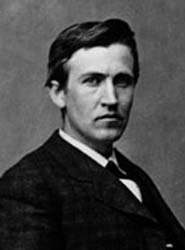
Thomas Alva Edison
|
Testla proceeded to explain his work and his idea for alternating current. Edison wasn't interested. Edison already had
an enormous amount of money invested in his own DC system and didn't want to change. He did recognize that this young man
from Europe was very talented and offered to hire him, promising him $50,000 if he could make certain improvements in his
DC generation plants.
Despite both being genius inventors, Tesla and Edison had very different styles. Edison was largely self-taught, while
Tesla had a formal European education. Edison discovered by trial and error, a method he expressed best in his famous saying,
"Invention is five percent inspiration and 95 percent perspiration." Tesla preferred to think about an invention and would
only build the actual model when he had it all worked out in his mind. Tesla's thinking was so precise that the first model
would almost always work the way he expected with no alterations.
Tesla once said of Edison:
If Edison had a needle to find in a haystack, he would proceed at once with the diligence of the bee to examine straw
after straw until he found the object of his search.. I was a sorry witness of such doings, knowing that a little theory and
calculation would have saved him ninety per cent of his labor.
It wouldn't be long before the men would clash. Just a few months after starting, Tesla finished his improvements and went
to Edison to get his $50,000. Edison, who probably thought that what he had sent Tesla to do an impossible job, refused to
pay, saying that the offer had not been meant to have been taken seriously. "When you become a full-fledged American, you
will appreciate an American joke," Edison quipped.
Disgusted, Testla resigned and soon got involved with investors who wished to build an improved arc lamp. They founded
the Tesla Electric Light Company. His design was a success, but all the money went to the investors. Tesla was soon
looking for another opportunity.
It came in the form of A.K. Brown of the Western Union Company. Brown agreed to invest in Tesla's idea for an AC motor.
In a small laboratory not far from Edison's office, Tesla developed all the components necessary for an AC generation and
distribution system along with his AC motor. Late in 1887 Tesla filed for seven U.S. patents on his AC systems. The inventions
were so unique that they were issued without a successful challenge.
The War of the Currents
George Westinghouse, inventor of railroad air brakes, heard about Tesla's system and visited him at his laboratory. After
viewing the inventions, Westinghouse paid $60,000 for the patents, which included $5,000 in cash and 150 shares of stock in
the Westinghouse Corporation. Westinghouse then used Tesla's AC system to challenge Edison's DC system for the future of electrical
distribution within the United States.
|
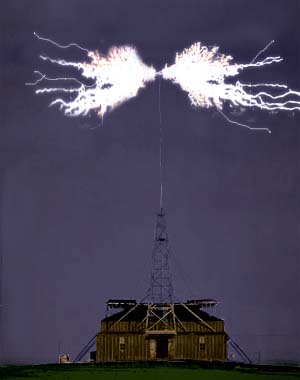
Artist conception of Teslas' resonant
transformer in action.
|
The AC system was clearly superior. In order to send electricity any distance, it must be at very high voltages. The voltage
in an AC system could be stepped up or down to different voltages very easily with a device called a transformer. Transformers
were not available for DC at that time, which meant that DC power couldn't be sent more than a few blocks because lower voltages
needed to be used in homes. A DC system like Edison's might require a power plant within a few blocks of every house, instead
of a single power plant for the whole city.
Edison, ignoring this, started a full scale propaganda campaign against Westinghouse, Tesla and AC current. He hired a
man by the name of Harold Brown to go around the country and demonstrate how AC was more dangerous than DC (something that
wasn't necessarily true) by staging shows where he electrocuted dogs and old horses. Brown referred to this process as being
"Westinghoused." Brown even managed to buy a used Westinghouse generator and get it hooked up to the world's first electric
chair at New York's Auburn State Prison so that AC would be associated with electrical executions.
Despite the smear tactics employed by Edison, it became clear that the AC system had many advantages. In 1892 the Chicago
World's Fair was lit entirely with AC power coming from twelve thousand-horsepower AC generation units located in the fair's
Hall of Machinery. Competitors had bid a DC system for the fair, but lost the job because the huge amount of copper needed
for such a DC system (because of its low effiencey) was too high.
As Westinghouse started winning the war, Edison was forced to merge his company with the newly formed General Electric
Corporation. General Electric would have taken control of Westinghouse too if it hadn't been for the generosity of Tesla.
Tesla gave up control of AC patents worth millions of dollars because he believed that an independent Westinghouse Company
was the only way his AC system would be widely adopted.
This move by Tesla ensured the future of AC, but left him short of cash to pursue his research in the future.
Taming Niagara Falls
As a boy Tesla had seen an engraving of the great falls of the Niagara river and dreamed of harnessing their power. In
1893 he actually got his chance. Lord Kelvin, the head of the commission in charge of a project to tap power from the falls,
originally had argued against Tesla's AC system, but changed his mind after visiting the Chicago World's Fair. Impressed,
Kelvin supported AC for the project and Westinghouse won a contract to build a powerhouse at the falls.
|
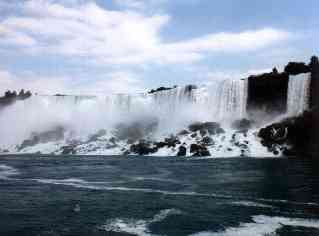
Tesla dreamed of taming the power
of Niagara Falls.
|
Tesla designed the systems and was confident they would work, though a project of this magnitude had never before been
done. Investors, including J.P Morgan, were nervous about the success of the venture. The project was difficult, expensive
and took five years to complete. On November 16, 1896, when the switch was thrown, Tesla's systems worked perfectly. One by
one each of the ten planned generators came online over a few months. The Niagara power station generated some 15,000 horsepower
of electricity, a phenomenal amount for the time.
Newspaper and engineering journals agreed that, as the New York Times put it, Tesla deserved the "undisputed honor" of
making the project possible. Lord Kelvin said Tesla had "contributed more to electrical science than any man up to his time."
Experimenting with High Frequency
Back at his laboratory in New York City, Tesla started to look into what happened with electricity when you alternated
it at extremely high frequencies. At first he tried altering one of his AC generators to do this, but the machine flew apart
when it reached twenty thousand cycles (alterations) per second. To go further he had to invent a new device. Dubbed the "Tesla
coil," it could take normal household current (60 cycles a second) and step it up to thousands of cycles per second. The coil
could also generate extremely high voltages.
Testla thought that high frequency electricity would have many advantages: Lamps would give out more light, electricity
would travel more efficiently through wires, and systems would be safer because high frequency electricity passed across the
surface of a person's body rather than through it.
Using this technology, Tesla tried to make better and brighter lamps than the incandescent bulbs Edison had marketed so
successfully. In incandescent lamps, only about 10 percent of the energy it uses comes out as light. Tesla hoped he could
find a better solution. His work resulted in the first neon and fluorescent lights ever made. It was during this phase of
his experimentation that he discovered that he could make a lamp light with no wires attached to it at all just by using high
frequency electricity that would pass through air. The effect would eventually be known as radio transmission.
By using a Tesla coil tuned to the same frequency as another Tesla coil sending energy, Tesla realized that he could send
signal through thin air. He was about to demonstrate this in 1895 by sending a signal 50 miles to West Point, New York, when
his lab caught fire and burned down. For this reason he didn't get to file a patent on the system until 1897. Unfortunately,
an Italian inventor, Guglielmo Marconi, had filed a patent in England in 1896 for a less capable system. As Marconi worked,
at first Tesla was unconcerned about his progress saying, "Marconi is a good fellow. Let him continue. He is using seventeen
of my patents", but later a fight broke out between the inventors over who had first invented radio. The fight would became
particularly bitter when Marconi won the Nobel prize for the invention in 1911. Marconi's first American patent application,
made in 1900, was denied because of Tesla's earlier patent, but later the U.S. patent office reversed its decision, giving
a patent to Marconi. It wasn't until 1945, two years after Tesla's death, that American courts upheld Tesla's patent and his
claim to the invention of radio.
Robotic Boat
From radio signals it was only a short hop in Tesla's agile mind to radio remote controls. In 1898 at an electrical exhibition
in Madison Square Garden, Tesla had a small indoor pond built and into this pond he placed a strange iron-hulled boat that
looked like a small bathtub with a lid. By using radio signals, Tesla was able to control the boat's motor, sending it zipping
around the pond seemingly under its own control. He even installed lights on it he could blink at a distance from his control
box. Many observers, unfamiliar with radio waves, thought that the device must have a brain of its own or that somehow Tesla
was controlling it with his mind. When it was first shown "it created a sensation such as no other invention of mine has ever
produced," Tesla would later write.
Tesla called the object a "teleautomaton" and thought of it as the first of many robotic inventions that would serve mankind.
When a reporter suggested that such a boat might be made to carry an explosive charge and used as a weapon of war, Tesla grew
angry. "You do not see there a wireless torpedo, you see there the first of a race of robots, mechanical men which will do
the laborious work of the human race."
Wireless Power
|
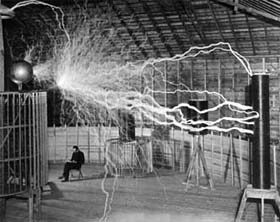
Tesla sits in his laboratory while
his lightning strikes around him in this trick photograph.
|
Tesla's experiments with radio convinced him it was possible to send not only electrical signals through the air, but power.
Conditions for this would be best at high altitudes where the air was thin. Knowing this, Tesla's patent lawyer and friend
Leonard E. Curtis, suggested that Tesla might set up a new laboratory near mile-high Colorado Springs, Colorado. Curtis owned
part of the El Paso Power Company located there and could get him free electricity for his experiments.
Tesla spent a year at the site in Colorado testing and experimenting with his "resonate transformer." The results convinced
him it was possible to send power through the air. In the spring of 1900 he packed up his Colorado laboratory and returned
to the East coast, determined to bring the world a new way to get electrical power. |
|
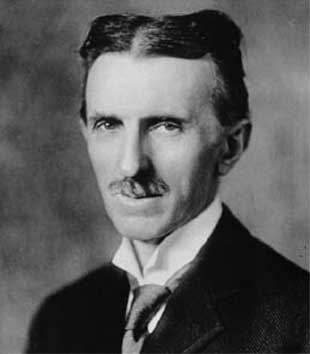
Nikola Tesla at age sixty-four.
|
Part Two:
Power Through the Air
During the first half of his life, Nikola Tesla invented the AC motor, radio, remote control, and harnessed
the power of Niagara Falls. Then he formed a scheme to deliver electrical power through the air. Would it work?
At his Colorado laboratory, Tesla thought he had conquered the problems of sending electricity through the air. This solution
allowed him to envision a whole new world with a global communication network powered by high frequency signals.
Before he could bring this new world into being, however, Tesla needed cash. To attract potential investors, Tesla agreed
to write a piece for Century magazine. It was entitled "The Problem of Increasing Human Energy" and was published in
the magazine's June 1900 edition.
In it, Tesla told of his vision for the future: the weather controlled via radio signals, war ended because it was entirely
fought by robots, the tapping of the sun's energy via a giant antenna, and power transmitted through the air without wires.
His system, a "world wide wireless" when "applied the earth will [allow it to] be converted into a huge brain, capable of
response in every one of its parts," Tesla would later say. The article read more like fiction than science, but the photos
that accompanied the article seemed even more unbelieveable.For example, one picture showed Tesla seated at a chair in his
Colorado laboratory while streamers of high voltage electricity snaked all around him.
Indeed, the picture seemed incredible because it had been produced with trick photography. The electrical bolts had been
photographed in a darkened room with a time exposure. Later, the same film was exposed again, this time to a room with Tesla
sitting quietly in a chair. When the film was developed, it gave the impression that Tesla had been sitting in the chair while
the electrical storm raged around him.
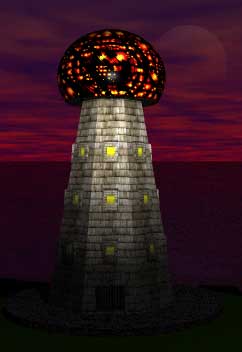
Artist's conception of what the Wardenclyffe
tower would have looked like if it had ever been completed. (Copyright Lee Krystek, 2002)
|
Wardenclyffe
The photographs and text did their work and attracted the attention of one of the wealthiest men of the day, J.P Morgan.
Morgan gave Tesla $100,000 to develop the "world-wide wireless" to send messages across the Atlantic. Tesla, though, had even
grander schemes than he let on to Morgan. His wireless station would not only transmit signals, but power.
The site chosen for his transmission station was located on the cliffs overlooking Long Island Sound at a place Testla
called Wardenclyffe. Construction began in 1900. The most remarkable part of the project was a 187-foot-tall tower topped
with a fifty-five-ton sphere made of steel. Beneath the tower, sixteen iron pipes were driven three hundred feet into the
earth. The construction costs quickly exceeded the money provided by Morgan, however, and the financier was reluctant to give
any more.
Morgan was further convinced that additional financing was not warranted when on December 12, 1901, Marconi sent the letter
"S" across the Atlantic from Cornwall, England, to Newfoundland by wireless. Marconi's approach was much cheaper than Tesla's
and Morgan saw no reason to invest any more in Wardenclyffe. Tesla's stock among Wall Street investors was falling and he
himself observed, ""My enemies have been so successful in portraying me as a poet and a visionary," he said, "that I must
put out something commercial without delay."
Tesla could not find any more backers and most of the site's activity had to be shut down in 1905. Newspapers referred
to it as, "Tesla's million-dollar folly." The failure of Wardenclyffe lead Tesla to a nervous breakdown.
Ironically, the person who lost the most in the failure of Wardenclyffe besides Tesla might have been J.P. Morgan. Tesla's
design for a multi-channel, multiplex, wireless system was much superior to Marconi's design and probably would have made
Morgan an additional fortune if he had only continued his investment.
Tesla's Turbine
|
Did Wardenclyffe Cause the Great 1908 Siberian
Explosion?
In 1908 large parts of Siberia were flattened by an enormous and
mysterious explosion. The evidence has led most scientists to suspect that a large asteroid or comet entered the atmosphere and exploded over
that isolated region.
Some people, however, have suggested that the explosion was the result of an experiment by Tesla at Wardenclyffe.
The Wardenclyffe story may have its roots in an article published in 1908 in Wireless Telegraphy & Telephone.
In the article Tesla says that he would soon be able to direct electrical energy "with great precision" to any point on the
globe. Perhaps, proponents of this idea contend, he directed it to a point in remote Siberia?
As intriguing as this story was, there was very little happening at Wardenclyffe in 1908. While parts of the building were
still used until 1907, most of it was shut down, and the vital equipment had been removed several years earlier. The truth
is that Tesla had no equipment to run such a dangerous test (if indeed he would have) at Wardenclyffe in 1908. |
Tesla went back into the lab in 1906. Several years of effort resulted in the Tesla turbine. A normal turbine of that day
was basically a propellor in a housing that would spin a shaft as moving gas or liquid passed through the housing. Tesla's
design was radically different, however. It was a series of closely-spaced discs attached to a shaft. Gas or steam was injected
between the discs, spinning them at a high rate of speed.
The design was extremely efficient and Tesla envisioned it driving airplanes and automobiles as well as ships, trains and
trucks. By 1913 J.P. Morgan was dead, but Tesla was able to get a $15,000 loan from his son to further develop the turbine.
This amount, however, was not enough money to let Tesla overcome the problems that had shown up in the invention.
The discs in the turbine spun so fast that they quickly became deformed from heat. Tesla could never resolve this problem
with the metals available in those days and the promising invention had to be shelved.
Between 1905 and the beginning of World War II, friends began to notice changes in Tesla. Perhaps his disappointments with
the Wardenclyffe project and the turbine were some of the reasons he seemed more depressed, withdrawn and eccentric. Visiting
the local parks, he would rescue injured pigeons and take them back to his hotel room so he could nurse them back to health.
At that time he also became more secretive with his actual discoveries and more likely to speculate in the press about seemingly
impossible inventions and ideas.
Radar
Though some of his ideas seemed impossible to build, quite a few would turn out to near perfect predictions of future inventions.
As far back as 1900, Tesla had talked about the concept of using radio waves to detect objects at a distance. "For instance,
" he wrote in an article for the magazine Century, "by their [standing electromagnetic waves] use we may produce at
will , from a sending station, an electrical effect in any particular region of the globe; [with which] we may determine the
relative position or course of a moving object, such as a vessel at sea, the distance traversed by the same, or its speed."
In the August 1917 issue of The Electrical Experimenter, he went on to outline the principals of modern military radar
in detail. Tesla thought it could be used to find submarines (which turned out to be impractical because of the great attenuation
of electrical waves as they pass though water) but a similar design would be applied successfully to find aircraft and surface
ships during W.W.II. Iin 1934 when Dr. Emil Girardeau lead an effort to build and install the first French radar systems,
he credited Tesla, saying the equipment was "precisely apparatuses conceived according to the principles stated by Tesla."
In 1922, Tesla turned 65. To some his ideas started to seem old-fashioned. By now he was making a living as a consulting
engineer, but the solutions he delivered to his customers often seemed impractical.
In 1928 Tesla received his last patent, number 6,555,114, for an "Apparatus For Aerial Transportation." His idea was for
a VSTOL (vertical short takeoff and landing) aircraft of brilliant design, but unfortunately Tesla could never raise the money
to develop it.
The Death Beam
Tesla's last major scientific proposal, made in 1934, was his famous "death beam." Tesla had a hatred for war, and he thought
that if he could come up with a purely defensive weapon of great power it might be used to discourage aggression between nations.
A front page article in the New York Times on July 11 of that year was entitled, "TESLA, AT 78, BARES NEW 'DEATH BEAM'" and
told of the inventor's proposal that would "send concentrated beams of particles through the free air, of such tremendous
energy that they will bring down a fleet of 10,000 enemy airplanes at a distance of 250 miles..."
Tesla envisioned a string of power plants along a nation's coast supplying the energy to run the beams. Since the range
would be limited by the curvature of the Earth to about 200 miles, it would be effective against attacking aircraft and ships,
but could not be used as an offensive weapon on other country's homelands.
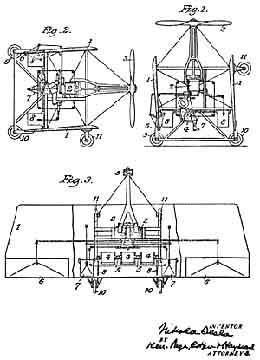
Plans Tesla filed to support his patent for a VSTOL
aircraft.
|
Again Tesla went to the younger Morgan for financing, but was turned down. He tried to interest the British government,
but after the Prime Minister Neville Chamberlain resigned, the British lost interest. Frustrated, Tesla then sent a technical
paper describing the weapon to a number of Allied nations. The paper was entitled "New Art of Projecting Concentrated Non-Dispersive
Energy Through Natural Media" and described what would later be termed a charged particle beam weapon.
Most engineers of the day considered such an invention impractical and no charged particle beam weapon played a role in
W.W.II. However, during the cold war between the Soviet Union and the United States several decades later, both would spend
considerable time and money trying to develop such a device.
Missing Papers
On January 7th, 1943, at the age of eighty-six, Tesla died in his room at the Hotel New Yorker. The controversy that often
surrounded his life did not end with his death. Within a few hours of his passing, Tesla's nephew, Sava Kosanovic, a Yugoslav
official, arrived at his room to find that many technical papers as well as the inventor's black notebook were missing. The
FBI investigated and later the rest of Tesla's effects were impounded not to be released until 1952 when some remaining papers
and possessions were sent to Belgrade, Yugoslavia, where a museum had been established in Tesla's honor.
After the end of WW II, copies of Tesla's papers on particle beam weaponry used by a U.S. Airforce operation (code-named
"Project Nick") also mysteriously disappeared without a trace.
An engineer with the National Defense Research Committee of the Office of Scientific Research and Development analyzed
Tesla's papers that were left and reached the conclusion:
His thoughts and efforts during at least the past 15 years were primarily of a speculative, philosophical, and somewhat
promotional character often concerned with the production and wireless transmission of power; but did not include new, sound,
workable principles or methods for realizing such results.
The committee could not know what was in the missing papers, however. Did Nikola Tesla invent some secret weapon that is
still today cloaked from the public for reasons of national security? Or if he had designed such a weapon did he decide that
this knowledge was too powerful for anyone to possess and took the information to his grave? We may never know.
A Partial Bibliography
Tesla: A Man Out of Time
by Margaret Cheney, Dell Publsihing, 1983.
Tesla: Master of Lightning,
PBS webite at http://www.pbs.org/tesla/index.html
They All Laughed
by Ira Flatow, HaperPerennial 1993.
The Life and Times of Nikola Tesla
by Marc J. Seifer, Citadel Press Book. |
Source:
www.unmuseum.org
For more information see
The Tesla Memorial Society of New York Website
|
